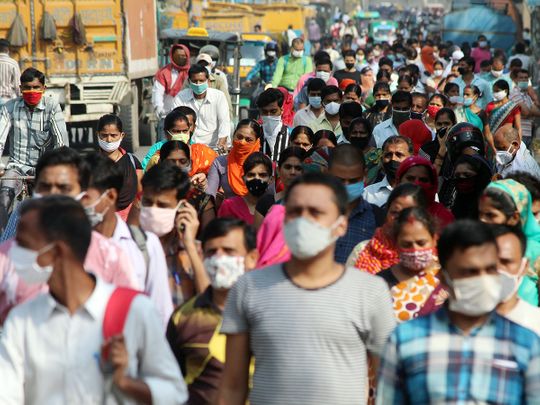
Surat: The hit that India’s dreams have taken from the coronavirus pandemic can be found in the hushed streets of Surat’s industrial zone.
You can see it in textile mills that took generations to build but are now sputtering, eking out about one-tenth of the fabric they used to make.
You can see it in the lean faces of the families who used to sew the finishing touches on saris but, with so little business, are now cutting back on vegetables and milk.
You can see it in the empty barbershops and mobile phone stores, which shoppers have deserted as their meager savings dwindle to nothing.
Ashish Gujarati, the head of a textile association in this commercial hub on India’s west coast, stood in front of a deserted factory with a shellshocked look on his face and pointed up the road.
“You see that smokestack?” he asked. “There used to be smoke coming out of it.”
Shrinking economy
Not so long ago, India’s future looked entirely different. It boasted a sizzling economy that was lifting millions out of poverty, building modern megacities and amassing serious geopolitical firepower. It aimed to give its people a middle-class lifestyle, update its woefully vintage military and become a regional political and economic superpower that could someday rival China, Asia’s biggest success story.
But the economic devastation in Surat and across the country is imperiling many of India’s aspirations. The Indian economy has shrunk faster than any other major nation. As many as 200 million people could slip back into poverty, according to some estimates. Many of its normally vibrant streets are empty, with people too frightened of the outbreak to venture far.
Much of this damage was caused by the coronavirus lockdown, which experts now say was at turns both too tight and too porous, both hurting the economy and spreading the virus. India now has the fastest growing coronavirus crisis, with more than 80,000 new infections reported each day.
A sense of malaise is creeping over the nation. Its economic growth was slowing even before the pandemic. Social divisions are widening. Anti-Muslim feelings are on the rise, partly because of a malicious social media campaign that falsely blamed Muslims for spreading the virus. China is increasingly muscling into Indian territory.
Scholars use many of the same words when contemplating India today: Lost. Listless. Wounded. Rudderless. Unjust.
“The engine has been smashed,” said Arundhati Roy, one of India’s preeminent writers. “The ability to survive has been smashed. And the pieces are all up in the air. You don’t know where they are going to fall or how they are going to fall.”
In a recent episode of his weekly radio show, Modi acknowledged that India was “fighting on many fronts.” He urged Indians to maintain social distancing, wear masks and keep “hale and hearty.”
Demand destruction
India still has strengths. It has a huge, young workforce and oodles of tech geniuses. It represents a possible alternative to China at a time when the United States and much of the rest of the world is realigning itself away from Beijing.
But its stature in the world is slipping. Last quarter the Indian economy shrank by 24%, while China’s is growing again. Economists say India risks losing its place as the world’s fifth largest economy, behind the U.S., China, Japan and Germany.
“This is probably the worst situation India has been in since independence,” said Jayati Ghosh, a development economist at Jawaharlal Nehru University in New Delhi. “People have no money. Investors aren’t going to invest if there is no market. And the costs have gone up for most production.”
Many neighborhoods in the capital of New Delhi where low-paid workers used to live are deserted, shell-like, a hot wind blowing through empty, tin-walled shacks. A few years ago, when the economy was expanding at a 9% clip, it was difficult to find a place to rent.
When Modi was swept to power in 2014 on a tide of Hindu nationalism, many Indians felt their nation had finally found the forceful leader to match their aspirations.
Quarter by quarter, India’s economic growth rate has been dropping, from 8% in 2016 to 4% right before the pandemic. Four percent would be respectable for a developed country like the U.S. But in India, that level is no match for the millions of young people streaming into the workforce each year, hungry for their first job.
Impulsive policies
Many of the complaints that investors make about India - the cumbersome land policies, the restrictive labor laws, the red tape - predate Modi. But his confidence and absolutism, the same qualities that appealed to many voters, may have added to the problems.
Four years ago he suddenly wiped out nearly 90% of India’s paper currency to tamp down corruption and encourage digital payments. While economists cheered both goals, they say the way Modi sprang this move on India did long-lasting damage to the economy.
That impulsiveness emerged again when the coronavirus struck. On March 24, at 8 p.m., after ordering all Indians to stay indoors, Modi shut down the economy - offices, factories, roads, trains, borders between states, just about everything - with four hours’ notice.
Tens of millions of Indians lost their jobs instantly. Many worked in factories or on construction sites or in urban homes, but they were migrants from rural India.
Fearing they would starve to death in city slums, millions poured out of the urban centers and walked, rode bicycles or hitched desperate rides back to their villages, an epic reverse migration from city to countryside that India had never seen. That dragged coronavirus into every corner of this country of 1.3 billion people.
Now, looking back on it, many economists trace the root of India’s interlocking crises - spiraling infections and a devastated economy - to this moment.
“India’s embarrassing slowdown in the second quarter of 2020 is almost entirely because of the nature of the lockdown,” said Kaushik Basu, a former chief economist at the World Bank and now a professor at Cornell. “This may have been worth it if it arrested the pandemic. It did not.”
He called the approach “lockdown-and-scatter” and said Modi’s policies had been a “failure.”
Read more
- India to invest $1.46 trillion to lift virus-hit economy
- India's economy contracts 23.9% between April to June, and its worst ever
- World Bank may project steeper contraction of Indian economy for FY21
- Indian government consumption key to growth in economy amid pandemic, central bank says
- Is India’s failing economy and job crisis pushing the country to civil strife?
A few parts of the economy are doing OK. Agriculture has been lifted by strong monsoon rains. In some cities, like New Delhi, many businesses are open again, though they might have new signs on the doors that say: “No more than 3 People Inside” or “Flat 40 Percent Off!”
But the virus and the economy are intertwined, and India’s virus graph is a steady staircase, going up. India is also No. 3 in virus deaths, though its per capita death rate is much lower.








